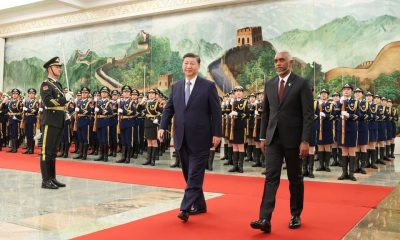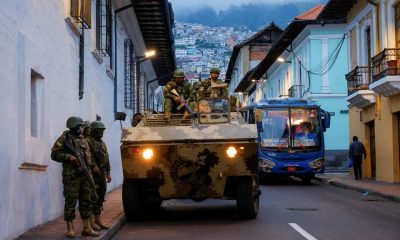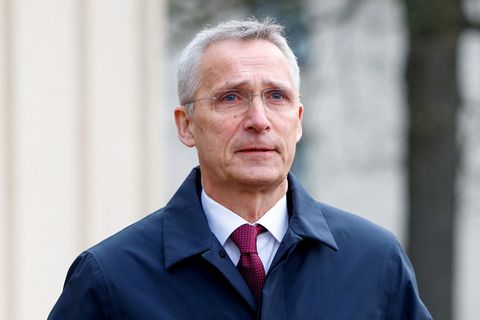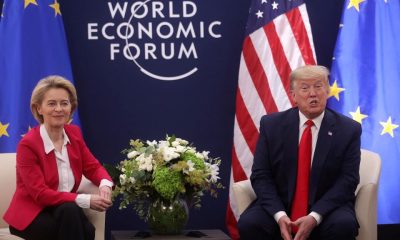Asia Pacific
Fearing China, South Korea targets firms building Taiwan navy submarines
According to a police document seen by Reuters and two people familiar with the situation, South Korean authorities cited the possibility of Chinese economic retaliation when they accused marine technology company SI Innotec of breaking trade laws for its work on Taiwan’s new military submarine program last year.
Police said they feared a repetition of the severe penalties imposed by Beijing in 2016 when Seoul agreed to install THAAD, a U.S. anti-missile system, in an affidavit to a judge on February 17, 2022, calling for the arrest of SI Innotec executive director Park Mal-sik. Late in 2017, China consented to relax such restrictions.
The affidavit says that SI Innotec’s deal to give Taiwan equipment for making submarines “directly impacts the overall security of South Korea.” After talking to the country’s arms sales regulator, police were “concerned about a crisis similar to a second THAAD deployment, such as economic retaliation.”
According to the affidavit, the Defense Acquisition Program Administration (DAPA) regulator informed an unnamed subcontractor that the government had “export concerns” about Taiwan and “takes a very cautious stance” on such licenses.
According to a source familiar with the situation, the court ordered Park’s detention on February 28 because he presented a flight risk and would tamper with evidence.
Police referenced China’s enraged response to a 2021 Reuters article on defense contractors and specialists from South Korea and six other countries working on Taiwan’s submarine program in the sealed document Reuters read.
Park, who received a suspended jail term, and SI Innotec, who was penalized in August 2022, both maintain their innocence and have filed appeals. Park opted out of commenting through a business attorney.
According to court documents and four persons with knowledge of the situation, two more South Korean businesses that were purportedly suppliers to Taiwan were also charged in November with violating trade regulations, and one of its senior executives was accused of industrial espionage.
The names of the co-defendants in their secret trial have not previously been disclosed, nor have the names of the defense engineering subcontractors Keumha Naval Technology (KHNT) and S2&K. Reuters could not ascertain if the ongoing procedures covered geopolitical problems.
A KHNT officer confirmed an ongoing criminal case while speaking to the media anonymously because he had no right to do so. The business refuses to speak further. S2&K did not respond.
Taiwan debuted its first indigenous submarine on September 28 in the southern port city of Kaohsiung amid escalating military tensions with China. The ship is about to start sea testing.
Interviews with seven individuals with connections to the military, shipbuilding, and judicial systems and the SI Innotec affidavit demonstrate how political worries about a trade war with China, Seoul’s biggest trading partner, have affected South Korea’s investigations into the three businesses. The individuals discussed ongoing judicial processes with ramifications for national security under the condition of anonymity.
According to an individual acquainted with the subcontractor, Seoul’s foreign ministry was “completely against” KHNT’s involvement with Taiwan and informed DAPA of its dissatisfaction.
According to the affidavit, several companies with submarine knowledge shied away from assisting Taiwan because they did not anticipate official permission given the possibility of “bigger damage to (the) economy than benefits,” including a potential Chinese export embargo to South Korea.
Police cited worries over national security in their refusal to speak. The three subcontractors were accused, but the prosecutor’s office did not comment on the current court case. Through the office of a former assistant, Reuters sought to get in touch with then-president Moon Jae-in. The office asked questions and directed them to the foreign ministry.
The foreign ministry claimed to be aware of the ongoing proceedings and forwarded specific inquiries to DAPA. DAPA has no more remarks except that it adheres to the law when making export judgments.
According to a police detective who requested anonymity to discuss current legal proceedings, Moon’s liberal administration departed office in May 2022. It was under no obligation to take action against SI Innotec.
Beijing may have pressured Seoul to crack down on the enterprises, although Reuters could not confirm this.
A representative for the Chinese Foreign Ministry accused Taiwan’s Democratic Progressive Party of “colluding with external forces” in response to a request for comment from Reuters. The official did not respond to a question about whether Beijing pressured Seoul regarding the subcontractors. Beijing stated to Reuters in 2021 that nations supporting Taiwan’s initiative were “playing with fire.”
The foreign and defense ministries of Taiwan declined to comment.
While its businesses sign arms agreements with other Asian neighbors, Seoul has no official diplomatic connections with Taipei. It has refrained from arming the democratically run island that China claims sovereignty over.
GLOBAL EXPERTISE
Taiwanese President Tsai Ing-wen launched the Indigenous Defense Submarine Initiative in 2016.
The new ships, which complement two that the Netherlands provided in the 1980s, are a “strategic deterrent,” according to the Taiwanese admiral in charge of the project, making it more difficult for China to project naval might in the Pacific.
According to many military analysts, an increased Taiwanese submarine force may make a possible invasion by Beijing more difficult. However, U.S. officials caution that such resources shouldn’t be sacrificed in favor of smaller arms that might enable Taiwan to engage in “asymmetrical warfare” with China’s much bigger arsenal.
Taiwan benefited from the experience of retired South Korean navy officers, including managers at SI Innotec and KHNT, who do not need authorization from the defense ministry before working abroad by law.
The Foreign Trade Act, which necessitates DAPA’s consent to transfer various “strategic goods” for military purposes, is allegedly broken by SI Innotec.
According to four people familiar with the criminal proceedings, the regulator is also entrusted with encouraging exports. This mission calls for officials to make difficult judgments on agreements that might annoy China but are nonetheless lucrative.
According to contracts submitted at trial, SI Innotec and Taiwanese shipbuilder CSBC reached an agreement in 2019 to provide and install $12 million in welding and assembly equipment to produce submarine pressure hulls.
According to SI Innotec, who spoke to Reuters, the equipment wasn’t made specifically for military use and didn’t use sensitive technologies.
According to SI Innotec, CSBC requested that the equipment’s principal application be described as wind energy generation in the contract. According to it, Taiwanese clients are cautious about defense activity, and dual-use equipment contracts are “customary” to be “signed for industrial use, not exposing military use,” according to Reuters.
Offshore wind power is a business for CSBC, which is in charge of building the submarines. Regarding its contracts, it refuses to comment.
According to court records, DAPA proposed SI Innotec contact it in April 2020 to see whether the equipment would be classified as military products and require export authorization.
In response to inquiries from Reuters, the subcontractor claimed that it had informed DAPA that it was exporting dual-use items, which are subject to a self-certification procedure that the regulator does not supervise. According to SI Innotec, the findings of the self-certification revealed that no export clearance was required, and DAPA was notified.
The Changwon District Court imposed a 14 billion won ($10.42 million) punishment against SI Innotec in August 2022.
“The accused were fully aware that the subject equipment would be used to manufacture a military submarine,” the judge found.
After a “subjective and opaque” discussion with DAPA that depended on “limited data,” SI Innotec claimed that police had classified their equipment as “military goods.” If not for Taiwan, it claimed to have “strong doubts” about whether its shipments would be regarded as military-grade.
According to two people familiar with his activities, SI Innotec CEO Park Moo-sik, who was not directly accused, is still working on the project in Taiwan. He declined to respond by way of the company’s attorney.
PERMISSION QUESTION
According to two persons acquainted with the subcontractor’s arrangement, KHNT and its chief executive, former navy commander Yang Hyang-Kwon, are accused of illegally transferring a submarine component to Taiwan.
According to court documents, Yang was jailed last year and freed on bond in March. Yang did not reply to requests for comment.
According to two persons acquainted with KHNT’s operation, the component was connected to a torpedo launching tube. S2&K, a co-defendant of KHNT, has expertise in these systems.
According to three people who knew the situation, KHNT went through the DAPA procedure. However, when it pushed forward to deliver specific plans to meet a deadline and needed a response, according to two people, it got none.
One claimed that this was when Seoul’s foreign ministry informed DAPA that the transaction was unfavorable.
Defense diplomacy expert and former military attaché in Taipei and Beijing, Cho Hyeon Gyu, remarked, “There are many things that South Korea can help Taiwan with but can’t in practice. He emphasized that Seoul’s relationship with China and the difficulty of covertly assisting Taiwan severely limited its ability to help.
Asia Pacific
China earthquake death toll rises to 149, two still missing after a week.
The death toll from the China earthquake rises to 149, with two still missing after a week. At least 149 people were murdered in a rural location in the northern part of China by one of the most severe earthquakes that China has seen in recent years, according to official media. Two people are still missing following the magnitude-6.2 earthquake a week ago.
The earthquake’s epicenter was located in an area encompassing both the provinces of Gansu and Qinghai. The Hui people of China, a relatively small ethnic minority that stands out for having a distinctive Muslim identity, reside in significant numbers in this area.
The quake’s violent vengeance was felt most strongly in Gansu. Almost 200,000 dwellings were destroyed, and 15,000 homes were on the verge of collapsing, according to reports from Chinese official media. In the province, the severe earthquakes caused 145,000 people to be displaced, and as of December 22, 117 people had been killed and 781 others had been injured.
According to official media, as of 11 p.m. (1500 GMT) on Sunday, 32 people had perished, and two more were still missing in the region of Qinghai, which is located west of Gansu.
The local authorities have determined that the shallowness of the earthquake is responsible for the severity of the damage. The thrust-type rupture during the earthquake and the comparatively soft sedimentary rock in the area contributed to the shakes’ significantly increased destructive power.
Most of the destroyed residences were constructed at an earlier age and were constructed out of brick-wood or earth-wood buildings. Because their load-bearing walls were created from the earth, the local authorities have stated they have inadequate defenses against earthquakes.
In addition, they stated that the tragedy has brought to light the critical need to increase the earthquake resilience of dwellings in rural areas.
Those provinces that are located on the northeastern limit of the tectonically active Qinghai-Tibetan plateau, which includes the majority of Tibet, Qinghai, Gansu, and sections of Xinjiang, as well as the rocky highlands in the western part of Sichuan, are prone to experiencing earthquakes.
In the province of Sichuan, a magnitude-6.6 earthquake occurred ten years ago, resulting in the injuries of over 6,700 people and the deaths of over 160 others. Two thousand seven hundred people lost their lives as a result of the devastating earthquake that struck Yushu, which is primarily Tibetan, in 2010.
Asia Pacific
North Korea vows more satellite launches, beefs up military on border.
On Monday, North Korea issued a warning that it will continue to exercise its sovereign rights, including through the launch of satellites. At the same time, reports indicated that its forces were repairing some guard posts destroyed on the South Korean border.
According to reports from North Korean official media, the foreign ministry of North Korea stated that monitoring the United States and its allies was the impetus behind the launch of a reconnaissance satellite last week.
“It is a legal and just way to exercise its right to defend itself and thoroughly respond to and precisely monitor the serious military action by the U.S. and its followers,” according to the KCNA investigation.
With nuclear weapons. North Korea launched the satellite on Tuesday, and the North Korean government claimed it had successfully entered orbit and sent images. However, South Korean defense officials and analysts stated that the capabilities of the satellite had not been independently verified.
Following the launch, South Korea resumed aircraft monitoring along the demilitarized zone and suspended a crucial condition in an inter-Korean military agreement in 2018.
In response, North Korea said that the deal would no longer bind it and would instead position weaponry along the border with South Korea.
According to the defense ministry of South Korea, North Korean soldiers have been seen transporting heavy weaponry back into the Demilitarized Zone (DMZ) border and putting up guard posts, even though the two nations are supposed to have dismantled the guard posts as part of the deal.
According to estimates provided by South Korea, the North maintained around 160 guard stations along the DMZ, while the South maintained only 60. After the military accord was made in 2018, it was intended to reduce tension and prevent accidental military conflicts. As a result, each side destroyed 11 of them.
According to the South Korean defense ministry, which cited images taken by cameras located in the Demilitarized Zone (DMZ), armed North Korean personnel have been seen repairing damaged guard posts in many areas since Friday.
In addition, they were reportedly installing what seemed to be a recoilless rifle, a portable anti-vehicle weapon or light artillery piece, at a stronghold, according to the report, which also cited an image.
According to KCNA, North Korean leader Kim Jong Un paid another visit to the control center of the space agency in Pyongyang on Monday morning. While there, he studied fresh satellite photographs of several locations, including Rome and the Anderson Air Force base in Guam, which is located in the United States.
According to his office, South Korean President Yoon Suk Yeol was informed on the most recent acts carried out by North Korea and issued an order to prepare the troops.
Monday was an unplanned meeting of the United Nations Security Council that the United States convened to discuss the satellite launch that North Korea conducted.
On November 22, nine other members of the Security Council joined the United States in issuing a statement that condemned the North Korean satellite launch for utilizing ballistic missile technology and referred to the launch as a breach of several resolutions passed by the Security Council.
The Foreign Ministry of North Korea stated that the statement just demonstrated how dysfunctional the United Nations Security Council had become, with some member nations mindlessly following the United nations in releasing worthless pronouncements.
Despite Pyongyang’s ongoing testing of ballistic missiles with ever-increasing destructive potential, China and Russia, two of the five permanent members of the Security Council that each have a veto, have refused to participate in any fresh sanctions against the country.
They were absent from the most recent statement made the previous week.
America
Joe Biden and Xi Jinping meet amid disputes over military and economic issues
For the first time in a year, U.S. President Joe Biden met with Chinese Leader Xi Jinping on Wednesday, potentially reducing tensions between the two giants over military conflicts, drug trafficking, and artificial intelligence.
At the Filoli estate, a rural home and gardens around 30 miles (48 km) south of San Francisco, where they would later travel for an Asia-Pacific Economic Cooperation (APEC) forum session, Biden greeted the Chinese president.
Profound progress on the enormous gaps that separate the presidents of the United States and China may have to wait until another day. Still, they will work to ease tensions in what many consider the most significant relationship in the world.
Expectations are low as Biden and Xi debate issues on which the leaders have not been able to agree for a long time, including human rights, North Korea, the South China Sea, Taiwan, the Israel-Hamas conflict, and Russia’s invasion of Ukraine.
On Tuesday, Biden and Xi traveled to San Francisco, where they will attend the APEC conference.
Against the backdrop of Beijing’s territorial disputes with neighbors, a Middle East crisis alienating the U.S. from friends, and relative Chinese economic weakness, leaders of the twenty-one-nation group convene, accompanied by hundreds of CEOs in San Francisco to woo them.
According to experts, Xi will be hoping for a smooth meeting with Biden to demonstrate to those back home who are worried about the economy and declining foreign investment that he can manage ties between the two biggest economies in the world.
Despite attempts to remove homeless people from the streets, San Francisco’s well-planned visit by Xi could come undone. Protesters supporting and opposing China’s ruling Communist Party clogged the route from the airport to the conference venue, an unusual sight for Xi, who last traveled to the U.S. in 2017.
Far from the APEC conference site, the bilateral summit venue provides the leaders a blend of security, tranquility, and seclusion.
In an attempt to save rapidly strained relations, Biden has pursued direct diplomacy with Xi, placing his trust in the personal bond he has built with the most powerful Chinese leader since Mao Zedong over a dozen years.
The National University of Singapore’s political science professor, Chong Ja Ian, stated that Mao described the two sides’ tactics as “talk and fight, fight and talk” during the Chinese Civil War.
Chong said, “That is, to talk while building up forces.”
The White House hopes the meeting will pave the way for additional discussions.
Before the meeting, White House spokesperson John Kirby told reporters, “We’re all expecting that this will be a productive discussion today, and hopefully, a precursor to much more communication and dialogue between our two teams going forward.”
Iran, meddling in elections, and furanone
Biden is anticipated to put pressure on Xi during the meeting to use China’s clout to persuade Iran to refrain from provocative action or to encourage its proxies to get involved in activities that could spark a regional conflict between Israel and Hamas.
He is also anticipated to bring up human rights, the status of American citizens who Washington believes are being wrongfully detained in China, and alleged Chinese efforts to sway international elections.
Officials from the US were looking forward to concrete steps that would bring back staff-level talks between the two countries on a wide range of issues, such as military-to-military communications, reducing the flow of fentanyl, managing trade and climate, and keeping an eye on the development of artificial intelligence technologies.
U.S. officials claim that a large portion of the chemicals used to make fentanyl originate in China.
Before the meeting, the two nations agreed to support a new goal for renewable energy and committed to lowering methane and plastic pollution. However, their efforts to revive climate cooperation were put on hold when former U.S. Speaker of the House Nancy Pelosi visited Taiwan in 2022.
After the COVID-19 pandemic, Biden’s 80-year-old economy has performed better than most wealthy countries. He is running for office again.
Despite some disagreements regarding the Israel-Hamas conflict, he has rallied the country’s longstanding allies from Europe to Asia to oppose Russia in Ukraine.
Ten years younger than Biden, Xi has tightened control over state leaders, the media, the military, and policy, including amending the constitution. However, the country’s three-decade growth trajectory has been off due to economic issues.
Officials from all across the region anticipate that Beijing will put Washington to the test in the upcoming weeks, capitalizing on what it perceives to be a shift in American attention away from Ukraine and Israel and toward its own goals in the Indo-Pacific.
Biden is anticipated to inform Xi that American commitments in the Indo-Pacific region remain unaltered. China’s actions in the Taiwan Strait, South China Sea, and East China Sea—areas of international dispute—have alarmed its neighbors in recent years.
-

 Europe7 months ago
Europe7 months agoRussia’s Shoigu accuses the West of seeking to expand the Ukraine war to the Asia-Pacific.
-
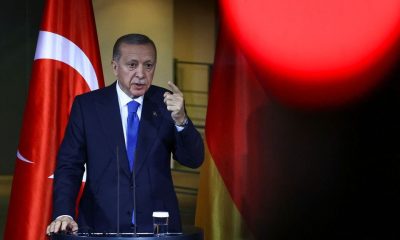
 Geopolitics & Foreign Policy6 months ago
Geopolitics & Foreign Policy6 months agoTurkey’s Erdogan says he may visit Egypt soon, discuss Gaza patients -media.
-

 America8 months ago
America8 months agoRepublican US House to hold first Biden impeachment inquiry hearing
-

 Geopolitics & Foreign Policy6 months ago
Geopolitics & Foreign Policy6 months agoRussia deploys new nuclear missile in Kaluga region – RIA
-

 Geopolitics & Foreign Policy6 months ago
Geopolitics & Foreign Policy6 months agoCeasefire takes hold in Gaza ahead of hostage release; aid enters enclave.
-

 Gender, Sexuality & Identity8 months ago
Gender, Sexuality & Identity8 months agoGreenland women ask Denmark for compensation over involuntary birth control.
-
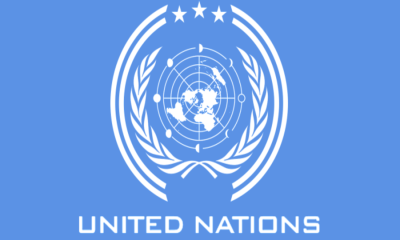
 Global Issues & Cooperation8 months ago
Global Issues & Cooperation8 months agoHuman rights in Russia have ‘significantly deteriorated’ – UN expert.
-
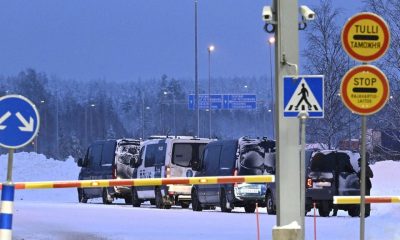
 ECONOMY5 months ago
ECONOMY5 months agoFinland will sign a defense pact with the US.




